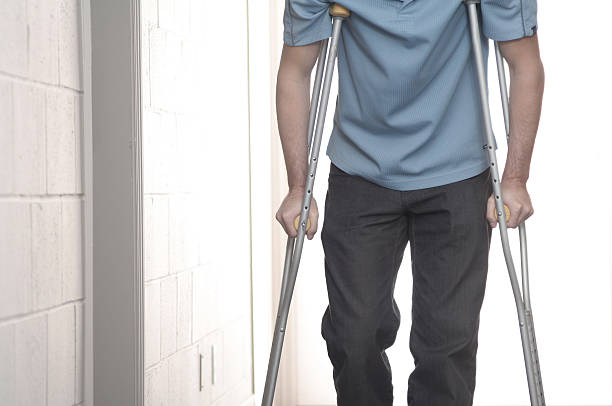An injury to your hips or feet can largely restrict your physical mobility. Doctors usually recommend using walking devices after certain injuries to avoid any future damage or prolonged injury. Using a walking device may also make your recovery easier by helping you with your balance when performing daily tasks like getting dressed, cooking, showering - or even simple things such as going out on errands.
The first time you learn to use a walking aid can be an intimidating experience. However, with just a few tips and some practice, most people are able to quickly gain confidence in their abilities and walk independently!
Tips for Using Crutches
Weight-bearing
When you are recovering from a leg injury, it is important to limit the weight-bearing through your injured leg. It may even be necessary for doctors to place restrictions on how much weight you can put on that injured limb because the healing process takes time.
Non-Weight-bearing
If you are non-weight bearing, then your only option is to push through your hands on the crutches in order to keep all of your weight off of your injured foot. As soon as you start walking, there is no pressure on that foot from leaning too much into those armpits.
Weight-bearing as Tolerated
If you are weight-bearing as tolerated, then you can put pressure on your injured leg as long as it does not cause you any pain. However, if you feel any pain or discomfort, stop immediately and consult a medical professional right away.
Partial Weight-bearing
If you are partially weight-bearing then the majority of your body's weight should not be on one foot. You will need to use crutches for balance and stability, while still holding onto them with both hands in order to keep a steady footing.
Toe touch Weight-bearing
Toe Touch weight-bearing is a test to find out if you are ready for walking. With this type of weight-bearing, it's important that the entire foot rests flat on the ground, not just your toe or heel.
Tips for Walking on Crutches
With a railing
- Hold the hand railing firmly with either your right or left hand (whichever is comfortable), and place both crutches under your other arm
- Stand at the bottom of a staircase with the uninjured foot on the floor and lift up your injured leg off the floor
- By still holding the handrail firmly, try to step with your uninjured leg
- Bring both crutches and the injured foot up to the next step
- Make sure to bring the injured foot to the step as well, but do not put any pressure on it
- Take one step at a time
- Repeat the same process by taking the next step with your uninjured leg
Without a railing
- Be mindful of your balance and try to attempt the process as deliberately as possible
- Place one crutch under each arm while you climb the stairs (bearing weight with hands)
- Step on the first step by using your uninjured foot and then lift both the crutches and the injured foot to move onto the next step
- Repeat this process as slowly as necessary
Some Important Reminders
When you've injured your leg, using the stairs can be a challenge. You need to have good balance and strength so that you don’t hurt your injured foot when going up and down the stairs. But if you don't feel comfortable navigating this obstacle on crutches, there are other ways of getting around! One option is sitting on the steps and using your hands to go up or down the stairs.
Moreover, it is important to know the proper way to use crutches. For starters, you should not be putting your weight in your armpits when using crutches or else it will lead to nerve damage and pain down your arms. You can protect your hardworking hands by cushioning hand grips with adhesive pads or wear fingerless gloves for some extra protection.
Also, make sure to have the proper crutch size. To measure your arm length accurately for this purpose, stand up straight with your arms at your side and then place them as far back on the body as you can without bending over or leaning back too much. The top of the crutches should be 1-2 inches below that point in order to avoid shoulder strain from reaching outwards while walking; if they are higher than 2’’ under armpit level, you may not be able to bend forward enough during those moments.
Although it can be hard to use crutches, with time and patience it becomes second nature. However, if you experience any pain or numbness under your armpits while using them, consult a doctor. Be careful about where and how often you walk on stairs; if needed, this is something that needs professional attention from a physical therapist as well! And don’t worry, you will get all the help that is necessary.
Conclusion
Learning to walk with crutches after surgery or injury can seem awkward at first. But if you practice with patience, it won't take long before you're walking around like any other person! For more information, check this video out too! Click here
If you are using your crutches after a surgery, Reboundwear has you covered with everything you need for recovering from a surgery. We try to make your life as comfortable as possible.





Leave a comment
All comments are moderated before being published.
This site is protected by hCaptcha and the hCaptcha Privacy Policy and Terms of Service apply.